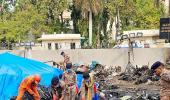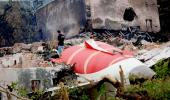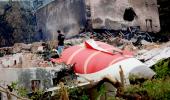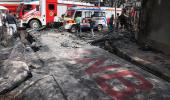'The crash site must be secured because something small -- like a pipe or hydraulic line -- could hold a critical clue.'

Captain Kishore Chinta, a retired squadron leader in the Indian Air Force and now chief pilot at Sirius India Airlines, brings decades of operational insight into civil and military aviation. Having flown MiG-21s and Mirage-2000s, and later trained as an air crash investigator, he explains how emergency response plans kick in when a disaster like the AI 171 crash strikes.
In the first of a three-part interview with Prasanna D Zore/Rediff, Captain Chinta details how roles are defined across airlines, airports, and agencies -- and why securing the crash site is absolutely critical.
The veteran pilot and accident investigator walks us through what kicks in the moment a crash like AI 171 occurs -- who calls whom, what drills are in place, how scavengers pose a threat to evidence, and why the crash site must be treated like a crime scene.
As someone who has investigated air crashes with the AAIB (Aircraft Accident Investigation Bureau), what are the first few steps you take when arriving at a crash site like AI 171?
Even before the AAIB comes to the scene, the DGCA (Directorate General of Civil Aviation) civil aviation requirements, as well as the flight safety manual of Air India, would have something called an Emergency Response Plan (ERP).
It's part of the safety manual approved for Air India. It is meant for any eventuality -- say the aircraft goes off the runway, which may not be life-threatening, or in case of an accident (like the AI 171 crash).
There is a flow chart that mentions what Air India will do and who all it will inform.
Part of this emergency response plan includes appointing a nodal officer and a designated person for media contact.
The nodal officer coordinates rescue efforts and liaises with the DGCA (the regulatory body that governs the operations of airlines in India), airport, and civil authorities.
The media contact person handles communication with families and the press.
All this is protocol -- laid down, documented, and approved.
This is true for all airlines, not just Air India. Every commercial operator, whether scheduled or non-scheduled, must have a flight safety manual that includes an emergency response plan.
The plan includes a flow chart, phone numbers, and protocols. It must be practiced at intervals specified in the manual -- every three months, six months, or annually -- through drills.
So drills are standard even for smaller airlines?

Yes. These mock drills are conducted whether it's a small airline or a large one with 500 aircraft. The drill protocol remains the same.
What happens at the accident site once an incident like AI 171 occurs?
Just as airlines have emergency response plans, so do airports and air traffic control. Every stakeholder at the airport has their own ERP. These include BCAS (Bureau of Civil Aviation Security), CISF (Central Industrial Security Force which looks after security at Indian airports), the airport operator, the Airports Authority of India, and any ground handling agency like AIASL (external link).
Each agency knows its responsibilities and whom to contact -- for fire services, the nearest police station, and other civil authorities.
The first and foremost concern, of course, is rescue and firefighting -- to save lives and control the damage.
Once that part is underway, ideally the area should be cordoned off by police. Anybody not involved in the investigation or rescue should not be allowed inside -- not the media, bystanders, or onlookers -- the perimeter of the crash site.
But from news reports, it seems too many people were walking in and out. Some may have posed as helpers or rescuers, but scavengers are always there, looking to pick up things. That's unfortunate but common.
Yet, the crash site must be secured because something small -- like a pipe or hydraulic line -- could hold a critical clue about the cause of the crash.
- Part II of the Interview: 'Nowhere In The AAIB's Mandate Is The Apportioning Of Blame'










